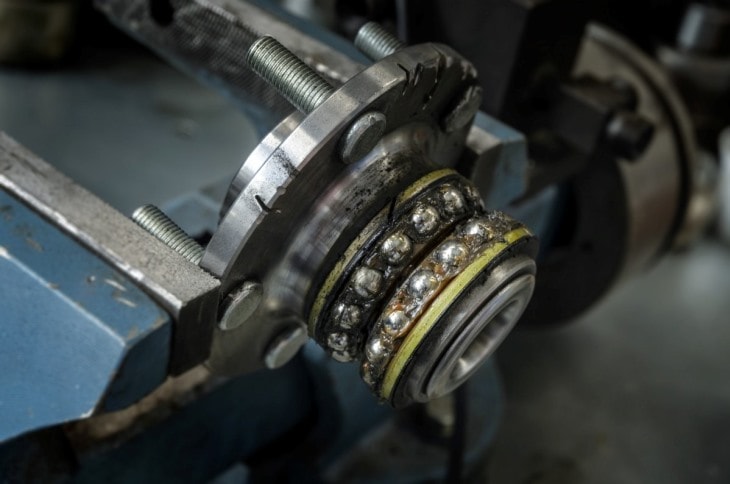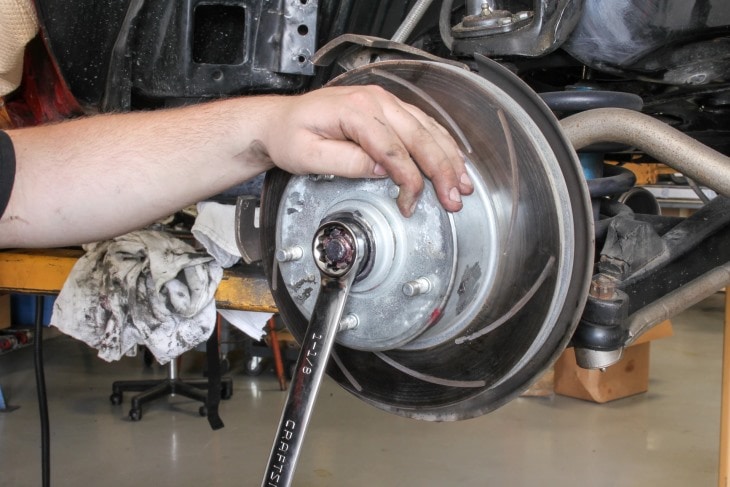Are you hearing a roaring sound when driving? Is your car “pulling” to the left or right? Are you praying for your wheel bearing to hang on for just one more day?
Regardless of the root problem, if you think your wheel bearing is in bad shape, then you will want to find out as soon as possible and get it fixed.
On average, it will cost around $500 to have a wheel bearing replaced. However, that hideous number can be reduced to about $100 if you DIY. But, before you break out the big bucks, you’ll want to make sure that the wheel bearing is really the problem. Roaring, whirling, or shaking could be a sign of a bad wheel bearing.
Table of Contents
- How to Tell If a Wheel Bearing is Bad (Common Symptoms)
- How Long Can You Drive on a Bad Wheel Bearing
- What Should Wheel Bearing Seals Be Checked For?
- What Happens When a Wheel Bearing Goes Out?
- How Much Does It Cost to Replace a Wheel Bearing?
- How Much Does It Cost to Replace a Hub Bearing?
- How Much Does It Cost to Fix a Wheel Bearing?
How to Tell If a Wheel Bearing is Bad (Common Symptoms)

Symptoms of a bad wheel bearing can be similar to other problems like a bad wheel. However, there are a couple of “tricks” you can use to figure out if a wheel bearing is bad and which one.
Drive
First, when you drive your car, listen for a whirling sound. It should sound like your grandma’s old washing machine.
Believe it or not, my grandma’s washing machine is very violent. The first time I used it, I thought an earthquake was happening because the floor was literally shaking. I nearly dove underneath the kitchen table!
Needless to say, if your car is making the same sound as an old washing machine, there is something wrong with it and it could be a wheel bearing.
Next, while you’re driving your car, turn the wheels slightly back and forth. If the sound gets louder, then the problem is with one of the front wheels. If not, then it is one of the back wheels.
While you can’t know which back wheel is the culprit from this test, you can know which front wheel it is. If you turn right and the sound gets louder, then it is the left wheel and vice versa.
Lastly, if you don’t hear anything but the steering wheel is vibrating, then it is possible that you have a silent but “deadly” problem on your hands (a bad wheel bearing).
Shake
Shake that wheel! The second test you can do is to raise your car up and shake the wheel that you think is bad. If there is some give, then it is likely that that wheel bearing is the culprit.
For further evidence, shake the wheel while paying attention to the CV axle. There should be no give to the axle. If it is moving back and forth, then you know it needs to be replaced.
Even if the axle is not moving back and forth, a wheel should never give to it. So, if you are able to shake the wheel, there is something wrong with it.
Tire Alignment
You can also check the tire for uneven wear. A bad wheel bearing can lead to the tire alignment being out of wack. So, you may notice uneven wear which can also cause your car to “pull” to the left or right when driving.
Spin
Lastly, you can spin the wheel. While this may seem like the most exciting test, you may be greeted by a raspy “hello.” If you hear a raspy sound, then it is likely that the wheel bearing needs to be replaced.
How Long Can You Drive on a Bad Wheel Bearing
The daredevil or frugal voice in you may be wondering how long you can drive on a bad wheel bearing. For those of you who like to live life on the edge, this is one situation where you don’t want to.
If you find out that your wheel bearing is bad, you will want to fix it as soon as possible. I definitely do not recommend competing in any street races or ramping your car when you have a bad wheel bearing.
A bad wheel bearing means that there will be a lot of friction that will only serve to break the wheel bearing down even more. This could even lead to your wheel coming completely off your car!
Though I have heard murmurs and whispers that you can drive for another 1,000 miles, I know of no one who has lived to tell the tale of how long their wheel bearing lasted.
So, with a heavy heart, I recommend living a more normal/boring life (just this once) and having your wheel bearing fixed.
What Should Wheel Bearing Seals Be Checked For?

The age-old question… Wheel bearing seals should be checked to make sure they are actually doing their job — sealing. If there are any leaks, then you know that the seal needs to be replaced.
The reason why the wheel bearing seal is critical is that it keeps undesirables out of the wheel bearing that could damage it, and it keeps the wheel bearing running smoothly.
Without a proper seal, water, debris, salt, etc. could get into your bearing and ruin it. A proper seal protects against rust and keeps the lubricant from leaking out.
If you ever find that your acceleration seems strained, then it could be caused by a lack of lubricant in the wheel bearing. So, you’ll want to thoroughly check the seal for any compromises. If you find none, then you’ll want to add more lubricant before you take off again.
- Check for any leaks
- Check to make sure the seal is not loose
- Check for any holes in the seal
If you do find that the seal is compromised, then you will want to replace it right away, as it will end up creating greater problems in the future and allow for the potential for rust to spread, “propagate,” and destroy.
What Happens When a Wheel Bearing Goes Out?
Eeeescheeechahhh *crash!*
For those of you who do not speak bloody murder, allow me to explain.
When a wheel bearing goes out, you could end up losing control of your car. It is also possible, though rare, that the entire wheel may come off!
To spell it out, you could crash, especially if you are driving at high speeds. So, if your wheel bearing goes out, drive slow and get it fixed.
How Much Does It Cost to Replace a Wheel Bearing?
Ah yes, the most important question. On average, you can expect to pay around $500. However, there are many components to consider such as the model of the car, the type of wheel bearing, and how much your mechanic charges for labor.
Front Wheel Bearing Replacement Cost
The front wheel bearing usually takes longer to replace and tends to have more parts to it. Because of that, you can expect to pay more for a front wheel bearing replacement than a back one.
You can expect to pay anywhere from $400 to $800 for a front wheel bearing replacement, depending on the type of wheel bearing and the shop that you go to.
If you want to skip the labor costs and DIY, then you can expect to pay around $50 to $150 dollars on parts. You won’t need power tools, but you will need some type of crank to remove the various bolts.
Back Wheel Bearing Replacement Cost
The back wheel bearings don’t take as long to replace, which means that you can save on labor costs.
You can expect to pay anywhere from $300 to $700 for a back wheel bearing replacement. It all depends on the type of wheel bearing and the shop you take it to.
If you want to DIY, then you can expect to pay around $50 to $200 dollars for parts. Again, you won’t need any power tools, you’ll just need a crank to remove the bolts and (since I’m not there) a jack for the heavy lifting.
How Long Does It Take to Replace a Wheel Bearing?
It does not take too long for a professional to replace a wheel bearing. For a back wheel bearing, you can expect an average of 30 minutes to replace it.
On the other hand, a front-wheel bearing takes a bit longer to replace. You can expect it to take about 1 hour for a professional to replace it.
However, if we are kindred spirits and you like to DIY, then, for a first-timer, it could take anywhere from 2 to 6 hours (give or take a second).
How Much Does It Cost to Replace a Hub Bearing?
A hub bearing is basically a combination of wheel bearing + hub assembly + speed sensor. While it may seem like replacing a hub bearing would be more expensive than a wheel bearing, that is not always the case.
You can expect to pay anywhere from $400 to $600 for a hub-bearing replacement. The cost is not exactly a cause for celebration, but it is definitely a welcomed surprise.
For those who detest labor costs, you can DIY for around $75 to $250. Beautiful! I love me some small numbers!
How Much Does It Cost to Fix a Wheel Bearing?

Typically, if your wheel bearing is bad, then it needs or should be replaced. However, if you catch it early, you may be able to save it.
For example, if you find that your wheel bearing is not getting enough lubricant. Then it may just be a matter of checking and fixing the seal and/or adding more lubricant.
It is also possible that an individual part, like a bolt or a sensor, is the culprit. If it is the bolt, then replacing the bolt or tightening it could fix the problem. If it is the sensor, then you will most likely need to replace the sensor.
To be clear, it is unlikely that you won’t need to replace the wheel bearing; however, you may be like my brother and have amazing luck.
Final Thoughts
All in all, a faulty wheel bearing should be replaced as soon as you realize it. While it may be a bit expensive to have a mechanic do it, you will have the peace of mind that it was most likely done right.
If you want to DIY, then you can for a decent reduction in the total cost with some basic “cave-man” cranks.

